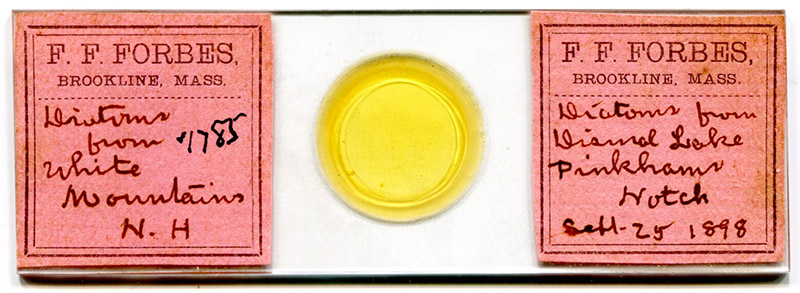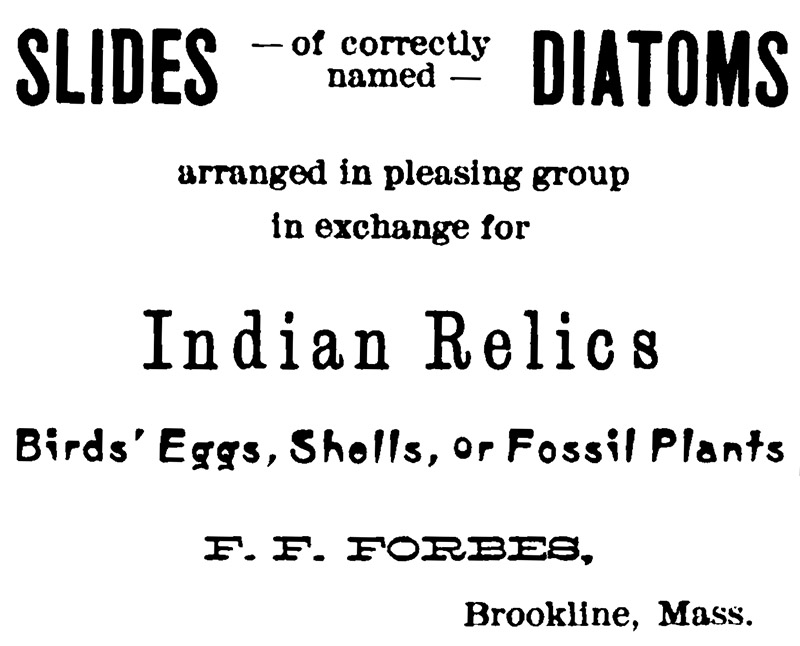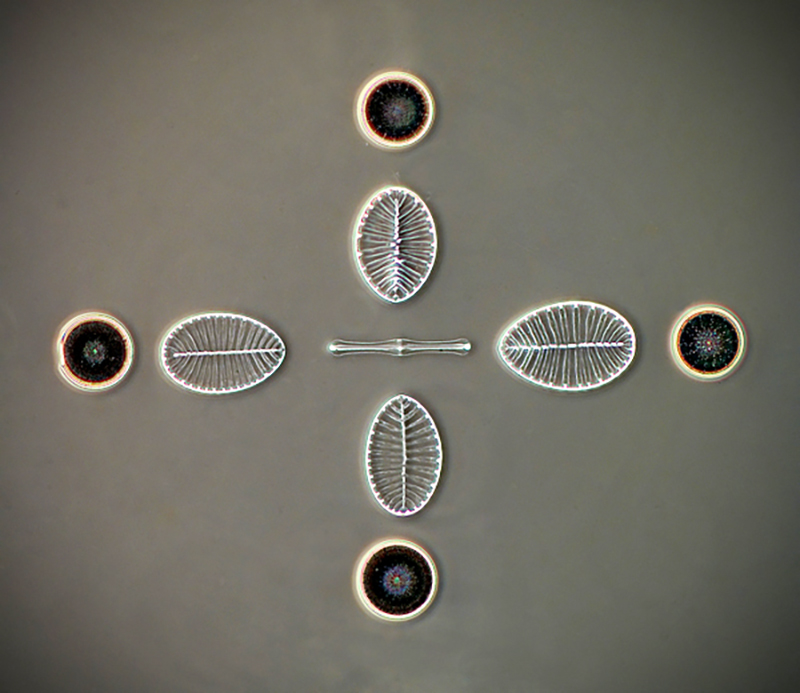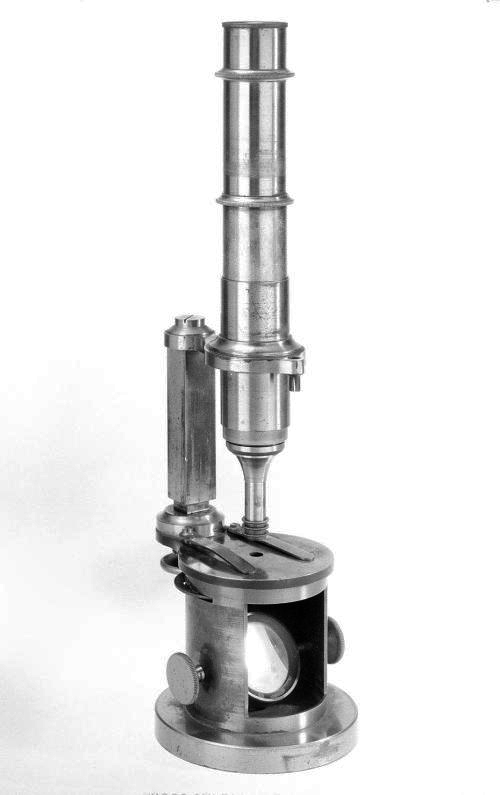
Figure 1. A 1898 strew mount of mixed diatoms from a lake in Pinkham’s Notch, New Hampshire, prepared by F.F. Forbes. He may have collected these specimens himself, or acquired them by exchange with another microscopist.
Fayette Frederick Forbes, 1851 - 1935
by Brian Stevenson
last updated November, 2020
F.F. Forbes was an amateur microscope slide preparer who advertised during the 1890s to exchange his preparations of diatomaceae. He prepared both strews and arrangements of diatoms from specific localities (Figures 1-4).
Forbes evidently discovered microscopy as a consequence of his work as superintendent of the water works in Brookline, Massachusetts, USA (in the western part of Greater Boston). His studies of the water in the city’s reservoirs led Forbes to evaluate diatom populations, and to recognize that some diatoms are associated with clean water and others with foul-tasting water. It was later stated that “Mr. Forbes … was one of the pioneers among waterworks engineers in the microscopical study of drinking water”.

Figure 1.
A 1898 strew mount of mixed diatoms from a lake in Pinkham’s Notch, New Hampshire, prepared by F.F. Forbes. He may have collected these specimens himself, or acquired them by exchange with another microscopist.

Figure 2.
Two 1892 exchange advertisements from F.F. Forbes, both from “The American Monthly Microscopical Journal”.

Figure 3.
An 1894 advertisement from F.F. Forbes, from “The American Magazine of Natural Science”.

Figure 4.
A Forbes arrangement of diatoms that he collected from Hammonds Pond, Brookline, Massachusetts. Adapted for nonprofit, educational purposes from http://diatoms.co.uk.

Figure 5.
F.F. Forbes’ microscope. It is not signed, but resembles instruments produced by Nachet in the 1860s. Adapted for nonprofit, educational purposes from http://waywiser.fas.harvard.edu/objects/16416/nachettype-drum-compound-microscope.
Fayette Frederick Forbes was born on May 9, 1851, on his parents’ farm in Buckland, Massachusetts. He was the first child of Frederick and Mary Ann Forbes. His birth record lists his given name as “Frederick Fayette Forbes” but, sharing the same name as his father, he was known through his life as “Fayette” or “F.F.”.
The Forbes family was evidently successful enough to send their eldest son to Williston Seminary in nearby East Hampton, where he studied civil engineering. Graduating at age 19, he then pursued further education at the Massachusetts Institute of Technology.
He then worked as a civil engineer for the Holyoke Water Works, then for the Troy & Greenfield Rail Road and the Boston & Albany Rail Road. In 1873, Forbes joined construction of the Brookline Water Works. Upon its completion, in 1876, he was appointed Superintendent of the Brookline Water Works, a position which he kept until his death.
Forbes married Rose Thayer during the mid 1870s. They do not appear to have had any children. Rose died in 1923. F.F. Forbes remarried in 1932, to a 60 year-old widow named Nina Marsh Kettembeil.
In 1891, Forbes published a paper on “the relative taste and odor imparted to water by some algae and infusoria”. He reported that large quantities of the diatom Asterionella formosa gives a “fishy odor” and rendered water unfit to drink. Also, Synura uvella was associated with an unpleasant acid taste. His studies did not make it clear whether the diatoms were directly responsible for the bad taste, or if certain water conditions allowed profusion of these diatoms.
Forbes advertised to exchange “slides of diatoms from peat bogs in Boston” and other locations in 1892 (Figure 2). He published a paid advertisement in 1894 in hopes of exchanging mounted slides for various other collectibles (Figure 3). Forbes prepared a box of slides for distribution through The American Postal Microscopical Club in 1895. The slide that is illustrated in Figure 1 indicates that Forbes continued to produce high-quality slides through at least 1898.
An 1893 publication on diatoms of the Boston area, by Arthur Edwards, included descriptions of material “received from Mr. F.F. Forbes, of Brookline, Mass., some earth from near the railroad cutting near Cottage Farms station, Boston, Mass., some diatoms from peat bogs around Boston, Mass., and from Mrs. Sara S. Fuller, who had them from Mr. Forbes, some dredgings from South Boston Point”.
The 1894 Scientists’ International Directory included notes of Forbes’ diverse interests, “Forbes, Fayette F., C.E., Supt. Brookline Water Works, Brookline, Mass. Bot: Phoen. and Crypt. Plants, Algae, Diatoms, Gen. Biol. C. Ex.”. The “C.” indicated that he collected specimens, and “Ex.” indicated his desire to exchange.
Through the years, Forbes amassed a substantial botanical collection (Figure 6). Substantial numbers of his herbarium are now held by Harvard University, the University of Connecticut, and other museums.
An 1899 publication on The Microscopy of Drinking-Water gave Forbes’ method for efficiently quantifying diatoms and other organisms in water, “The method of microscopical examination first used by the Massachusetts State Board of Health was that suggested by Mr. G.H. Parker. A piece of cotton cloth was tied firmly over the end of a glass funnel and 200 c.c. of the sample were made to pass through it. The organisms were left as a deposit on the cloth. After this straining the cloth was removed and inverted over an ordinary microscopical slip. The organisms, together with a small quantity of water, were dislodged upon the slip by blowing downwards upon the cloth through a piece of glass tube. This method was useful, but it did not give accurate quantitative results. Mr. F.F. Forbes of Brookline, Mass., used a modification of the cloth method. The water was filtered as in Parker's method, but the neck of the funnel passed into a tank from which the air was exhausted by an aspirator. This hastened the filtration and allowed a larger amount of water to be filtered”.
At a 1914 meeting of the Boston Society of Civil Engineers, “Mr. F.F. Forbes, Superintendent of Water Works of Brookline, will show a collection of microscopic slides, lantern slides and photographs illustrating the various kinds and shapes of these minute vegetable forms found in drinking water, this being made possible with the new stereopticon which permits the use of microscopic slides in the projection microscope, photographs and other opaque objects in the opaque projector as well as the usual lantern slides”.
Forbes died at his home in Brookline on November 20, 1935.

Figure 6.
Specimens of Dichanthelium lanuginosum, collected by F.F. Forbes on June 29, 1919. Adapted for nonprofit, educational purposes from https://portal.neherbaria.org/portal/collections/individual/index.php?occid=847067
Resources
American Magazine of Natural Science (1894) Advertisement from F.F. Forbes, Vol. 2, February advertising section
The American Monthly Microscopical Journal (1892) Exchange offers from F.F. Forbes, page 80
Denehy, John William (1906) A History of Brookline, Massachusetts, from the First Settlement of Muddy River Until the Present Time, 1630-1906, Brookline Press, Brookline, pages 240-243
Edwards, Arthur M. (1893) An examination of raised coast diatomaceae from around Boston, Mass., The Observer, Vol. 4, pages 272-274
Engineering News-Record (1924) George Chandler Whipple dies suddenly, pages 925-926
Forbes, F.F. (1890) A study of algae growths in reservoirs and ponds, Journal of the New England Water Works Association, Vol. 4
Forbes, F.F. (1891) The relative taste and odor imparted to water by some algae and infusoria, Journal of the New England Water Works Association, Vol. 6, pages 90-97
Global Plants (accessed November, 2020) Forbes, Fayette Frederick (1851-1935), https://plants.jstor.org/stable/10.5555/al.ap.person.bm000331255
Jelliffe, Smith Ely (1893) A preliminary report upon the microscopical organisms found in the Brooklyn water supply, The Brooklyn Medical Journal, Vol. 7, pages 593-616
Journal of the Boston Society of Civil Engineers (1914) January meeting of the Sanitary Section, Vol. 1, page 2
Journal of the New England Water Works Association (1935) Fayette F. Forbes, page 247
Massachusetts Department of Public Health (1890) Examinations by the State Board of Health of the Water Supplies and Inland Waters of Massachusetts, 1887-1890, Part 1, pages 733-734
The Scientists' International Directory (1894) “Forbes, Fayette F., C.E., Supt. Brookline Water Works, Brookline, Mass. Bot: Phoen. and Crypt. Plants, Algae, Diatoms, Gen. Biol. C. Ex.”, S.E. Cassino, Boston, page 77
US census and other documents, accessed through ancestry.com
Ward, R.H. (1895) Extract from report of management of the American Postal Microscopical Club for 1893-95, The American Monthly Microscopical Journal, Vol. 16, pages 105-107
Whipple, George Chandler (1899) The Microscopy of Drinking-water, J. Wiley & Sons, New York, page 3